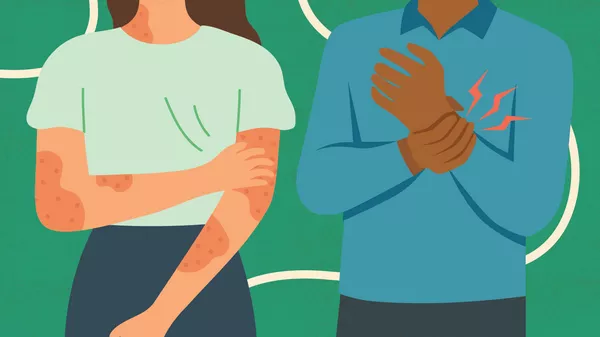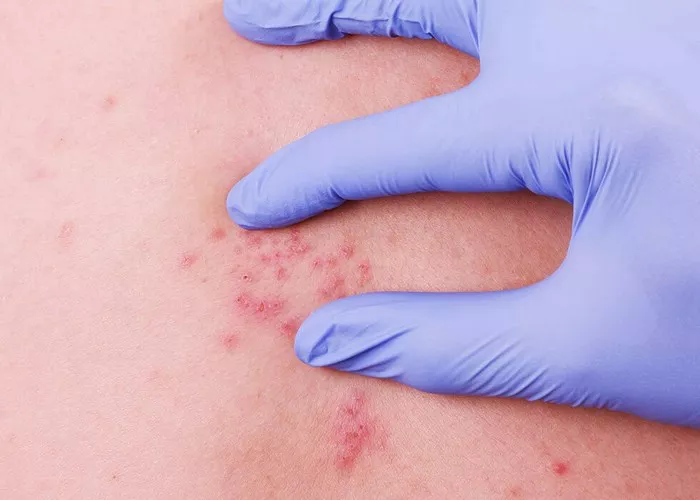Psoriatic arthritis (PsA) is a chronic inflammatory disease characterized by a combination of psoriasis and arthritis. It is a complex condition that can impact various parts of the body, including the skin, joints, and, as is increasingly recognized, the eyes. This article explores how psoriatic arthritis affects ocular health, delving into the mechanisms, symptoms, diagnostic challenges, and treatment options associated with ocular manifestations of PsA.
Understanding Psoriatic Arthritis and Its Systemic Impact
Psoriatic arthritis is an autoimmune disease where the body’s immune system mistakenly attacks its own tissues. This condition typically occurs in individuals with psoriasis, a skin disease marked by red, scaly patches. Approximately 30% of people with psoriasis develop PsA, which can cause joint pain, stiffness, and swelling. However, the impact of PsA extends beyond the skin and joints, affecting other organs, including the eyes.
SEE ALSO: The 5 Best Steroid Creams for Psoriasis
Pathophysiology of PsA and Its Ocular Manifestations
The precise cause of PsA is not fully understood, but it is believed to involve a combination of genetic, environmental, and immunological factors. In the context of ocular involvement, the inflammation characteristic of PsA can extend to various parts of the eye, leading to a range of eye-related issues. The inflammatory process in PsA can affect the eyes directly or indirectly through systemic inflammation.
Direct Ocular Involvement
Direct ocular involvement in PsA occurs when the inflammation associated with the disease extends to eye tissues. The primary ocular conditions related to PsA include:
1. Uveitis: Uveitis is the most common ocular manifestation of PsA, affecting up to 7% of patients with the condition. It refers to inflammation of the uvea, the middle layer of the eye, which includes the iris, ciliary body, and choroid. Uveitis can cause eye pain, redness, blurred vision, and light sensitivity. If left untreated, it can lead to severe complications such as glaucoma, cataracts, and even vision loss.
2. Conjunctivitis: Conjunctivitis, commonly known as pink eye, involves inflammation of the conjunctiva, the membrane covering the white part of the eye and the inside of the eyelids. While conjunctivitis is often associated with infections or allergies, in PsA, it results from chronic inflammation. Symptoms include redness, itching, tearing, and discharge.
3. Keratitis: Keratitis is inflammation of the cornea, the clear, dome-shaped surface covering the front of the eye. This condition can cause pain, blurred vision, sensitivity to light, and a gritty sensation in the eye. In PsA, keratitis may occur due to direct inflammatory processes or secondary to dry eye syndrome.
Indirect Ocular Involvement
Indirect ocular involvement in PsA stems from systemic inflammation and its impact on overall health. Chronic inflammation in PsA can contribute to conditions such as:
1. Dry Eye Syndrome: Dry eye syndrome, or keratoconjunctivitis sicca, is characterized by insufficient tear production or poor tear quality, leading to dryness, irritation, and discomfort. Systemic inflammation in PsA can affect the lacrimal glands responsible for tear production, exacerbating dry eye symptoms.
2. Secondary Glaucoma: Chronic inflammation in PsA can increase the risk of secondary glaucoma, a condition characterized by elevated intraocular pressure that can damage the optic nerve. Inflammatory debris and structural changes in the eye can obstruct the outflow of aqueous humor, leading to increased pressure.
3. Retinal Vasculitis: Retinal vasculitis involves inflammation of the blood vessels in the retina, the light-sensitive layer at the back of the eye. This condition can lead to vision disturbances, including blurred vision and blind spots, and in severe cases, it can result in retinal detachment or vision loss.
SEE ALSO: The 6 Best Body Scrubs for Psoriasis
Symptoms and Clinical Presentation
The ocular symptoms of PsA can vary widely depending on the specific condition and its severity. Common symptoms include:
- Eye Pain: Persistent or recurrent eye pain is a common symptom, particularly in cases of uveitis and keratitis. The pain may range from mild discomfort to severe pain affecting daily activities.
- Redness: Eye redness is a hallmark of ocular inflammation and can be seen in conjunctivitis, uveitis, and keratitis.
- Blurred Vision: Blurred or distorted vision can occur due to various factors, including inflammation, dry eyes, and secondary complications like glaucoma or cataracts.
- Photophobia: Sensitivity to light (photophobia) is a common symptom, especially in uveitis and keratitis.
- Tearing and Discharge: Increased tearing and discharge are typical of conjunctivitis and dry eye syndrome.
- Visual Disturbances: Patients may experience visual disturbances such as floaters, flashes of light, or blind spots, particularly in cases of retinal involvement.
Given the diverse range of symptoms, it is crucial for individuals with PsA to undergo regular eye examinations and promptly report any ocular symptoms to their healthcare providers.
Diagnosis and Diagnostic Challenges
Diagnosing ocular manifestations of PsA can be challenging due to the overlap of symptoms with other ocular conditions and the potential for multiple eye issues to occur simultaneously. A multidisciplinary approach involving rheumatologists and ophthalmologists is often necessary for accurate diagnosis and effective management.
Diagnostic Tools and Techniques
Several diagnostic tools and techniques are employed to assess ocular involvement in PsA:
1. Comprehensive Eye Examination: A thorough eye examination is essential to evaluate the overall health of the eyes and detect any signs of inflammation or structural abnormalities.
2. Slit-Lamp Examination: This technique allows detailed visualization of the anterior segment of the eye, including the cornea, iris, and lens. It is particularly useful for diagnosing uveitis and keratitis.
3. Fundoscopy: Fundoscopy, or ophthalmoscopy, involves examining the retina and optic nerve head. It is crucial for detecting retinal vasculitis and secondary glaucoma.
4. Optical Coherence Tomography (OCT): OCT is a non-invasive imaging technique that provides cross-sectional images of the retina. It is valuable for assessing retinal thickness and detecting macular edema or other retinal changes.
5. Fluorescein Angiography: This imaging technique involves injecting a fluorescent dye into the bloodstream to visualize retinal blood vessels. It is used to detect retinal vasculitis and other vascular abnormalities.
Differential Diagnosis
The differential diagnosis for ocular symptoms in PsA includes other autoimmune and inflammatory conditions, infections, and ocular surface diseases. Conditions that may present with similar symptoms include:
- Ankylosing Spondylitis: Another type of spondyloarthritis that can cause uveitis.
- Rheumatoid Arthritis: Can lead to dry eye syndrome and scleritis (inflammation of the sclera).
- Sarcoidosis: Can cause granulomatous uveitis and other ocular manifestations.
- Infections: Bacterial, viral, or fungal infections can mimic inflammatory ocular conditions.
Treatment and Management
Effective management of ocular manifestations in PsA requires a multidisciplinary approach involving both rheumatologists and ophthalmologists. Treatment strategies aim to control inflammation, alleviate symptoms, and prevent complications.
Medications
1. Topical Corticosteroids: Topical corticosteroid eye drops are commonly used to reduce inflammation in conditions like uveitis and keratitis. They can effectively manage acute flare-ups but are not suitable for long-term use due to potential side effects like increased intraocular pressure and cataract formation.
2. Systemic Corticosteroids: In cases of severe or refractory inflammation, systemic corticosteroids may be prescribed. These medications can effectively control systemic and ocular inflammation but are associated with significant side effects, necessitating careful monitoring.
3. Immunosuppressive Agents: Immunosuppressive agents such as methotrexate, azathioprine, and cyclosporine are often used in the long-term management of PsA to control systemic and ocular inflammation. These medications help reduce the frequency and severity of flare-ups.
4. Biologic Therapies: Biologic agents, including tumor necrosis factor (TNF) inhibitors (e.g., adalimumab, etanercept) and interleukin inhibitors (e.g., secukinumab, ustekinumab), have revolutionized the treatment of PsA. These targeted therapies can effectively control both joint and ocular inflammation.
5. Non-Steroidal Anti-Inflammatory Drugs (NSAIDs): NSAIDs can help alleviate pain and inflammation associated with PsA, including ocular symptoms. They are often used as adjunctive therapy.
Supportive Measures
- Artificial Tears: For patients with dry eye syndrome, artificial tears and lubricating eye drops can provide relief from dryness and irritation.
- Warm Compresses: Warm compresses can help alleviate symptoms of blepharitis and meibomian gland dysfunction, which can contribute to dry eyes.
- Protective Eyewear: Sunglasses and protective eyewear can help reduce photophobia and shield the eyes from environmental irritants.
Surgical Interventions
In cases of severe complications, surgical interventions may be necessary. These can include:
- Cataract Surgery: Cataract formation can occur due to chronic inflammation or long-term corticosteroid use. Cataract surgery can restore vision in affected individuals.
- Glaucoma Surgery: If glaucoma cannot be controlled with medications, surgical procedures such as trabeculectomy or implantation of drainage devices may be required to lower intraocular pressure.
Prognosis and Quality of Lithalmologists is essential to monitor disease activity and adjust treatment as needed.
Living with PsA and its ocular complications can impact quality of life, but with appropriate management, many individuals can maintain good visual function and overall well-being. Patient education and support are crucial components of comprehensive care, helping individuals understand their condition, adhere to treatment regimens, and recognize the importance of regular eye examinations.
Conclusion
Psoriatic arthritis is a multifaceted disease with systemic implications that extend to ocular health. Understanding the potential eye-related complications of PsA, recognizing the symptoms, and seeking timely medical intervention are essential for preserving vision and improving quality of life. Through a collaborative approach involving rheumatologists and ophthalmologists, effective management strategies can be implemented to control inflammation, alleviate symptoms, and prevent serious complications. As research continues to advance our understanding of PsA and its ocular manifestations, new treatment options and improved outcomes are likely to emerge, offering hope to those affected by this challenging condition.
Related Topics:
























